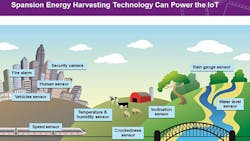It’s believed that energy harvesting will accelerate innovation in, and proliferation of, the Internet of Things (IoT). I talked with Tom Sparkman, senior vice president and general manager of Spansion’s Analog Business, about energy harvesting and the company’s technological advances in that arena.
Wong: What is energy harvesting and what factors in the market are driving its adoption?
Sparkman: Energy harvesting is the process of capturing and storing minute amounts of available energy from the surrounding environment, such as light, vibration, or temperature, and converting this energy to electricity in place of, or as a supplement to, battery power. Using batteries as an energy source has several drawbacks, including their cost and difficulty to replace. On top of that, they can be environmentally unpleasant and dangerous for children who are susceptible to swallowing them.
Natural resources such as solar, vibration, and thermal variations provide a sustainable “green” alternative that still gets the job done. We expect energy harvesting to be used as a power source in things like wearable devices and sensor nodes for wireless sensor networks, among other potential applications, contributing to the realization of a low-carbon society.
Wong: What is Spansion’s energy-harvesting technology?
Sparkman: We recently announced the Spansion Energy Harvesting family of power-management integrated circuits (PMICs). Our ultra-low-power buck PMIC, the MB39C811, enables efficient harvesting from both solar and vibration energy sources. And with its dual input, it can pull from two sources simultaneously—a key competitive advantage. Our ultra-low-voltage boost PMIC, the MB39C831, is for solar or thermal. This high-efficiency, synchronous-rectification boost dc-dc converter can charge a Li-ion battery with a single solar cell and a multi-junction solar cell or thermal electric generator. This family of devices works seamlessly with our ultra-low-power Spansion FM0+ MCUs, which are targeted at industrial and cost-sensitive applications with low-power requirements.
Additionally, we offer the Spansion Easy DesignSim tool, an easy-to-use online simulation environment that allows engineers to quickly select the parts they need to design their product. It features the industry’s only energy-budget calculator that simplifies application design by calculating the energy-budget balance while providing a recommended bill-of-materials list that can be purchased online.
Wong: Do you think energy-harvesting technology can replace batteries or at least curtail our dependence on batteries?
Sparkman: Yes we do, thanks to sustainable resources like solar and thermal energy, which have enabled us to think differently about how we power the multitude of devices around us. We are confident Spansion’s energy-harvesting PMICs will help our customers deliver more eco-friendly devices across a broad spectrum of applications. By weaning ourselves off of our battery dependence, we can open up new and exciting possibilities for the Internet of Things (IoT).
A good example of this is wireless sensor nodes. By using energy-harvesting technology, we can create low-cost smart sensor nodes without the need for wired connectivity or replacement batteries. These devices could be applied physically anywhere for contextual computing. A good use-case example is installing them within a specific doorway, where the sensors can take advantage of location-based priority information to monitor traffic within a factory floor or specific office area. Imagine how this can slash maintenance costs and lower operating expenses for larger companies implementing sensors throughout buildings and factories.
This file type includes high resolution graphics and schematics when applicable.
Wong: What applications are you targeting?
Sparkman: Spansion is targeting a wide variety of applications, from wireless sensor nodes like I mentioned earlier to light switches for buildings, to even technology that will monitor conditions on a golf course. A couple other interesting areas we are exploring include location devices for consumers that will allow retailers to offer special deals and technology to everything from consumer appliances, traffic, and factories to dams and rivers. Given the popularity of wearable devices like fitness and equipment trackers, especially related to healthcare, we also see a lot of potential in the implantable body device market.
Wong: How does it work?
Sparkman: What Spansion is doing is taking devices in the IoT, and instead of powering with batteries, our technology is harvesting energy from the environment.
The energy can come from a variety of sources, such as solar cells, vibration, or by a difference in temperature. What’s more, the energy-harvesting device itself can actually take into account two different energy sources, which is unique to the industry. Specifically, the technology pulls energy by using each harvester: solar cells from lighting or the sun; piezoelectric devices from vibration; and thermoelectric generators (TEGs) from thermal differentiation.
Basically, harvested power depends on the size of the devices and the energy source. Based on the harvested power, the application might change the operation from continuous operation to intermittent operation. Current technology is matched and balanced between the harvested power and the application.
Spansion’s energy-harvesting solution can support not only environmental energy, but also the coin battery for hybrid ac power supplies, USB bus power, and NFC power without data. Some great examples include home security systems, where you can have the sensors in all your windows and doors and never have to replace batteries, or in automotive applications, where you could eliminate the wires and the battery and the sensor information can be transmitted directly to the engine control unit of the car.
Wong: Why is this kind of technology necessary for the IoT?
Sparkman: The billions of sensors at the heart of the countless amounts of smart connected devices rely on batteries for power, which are costly, toxic to the environment, and require significant investment to maintain. It takes time, labor, and money to replace the billions of batteries around the world in everything from HVAC systems to security systems, to aisles and aisles of retail shelves, to sensors along every step in an automated factory. It’s believed that energy harvesting will accelerate innovation in, and proliferation of, the IoT.
Wong: How will the technology impact the market moving forward? What specific industries will be impacted now and in the future?
Sparkman: According to a recent report from Navigant Research, worldwide revenue from energy-harvesting systems will grow from $283 million in 2014 to nearly $375 million in 2020. We expect adoption to be earlier in U.S., with global adoption taking place in the next four to five years. One market that is sure to be impacted is the infrastructure market. This area will see the most benefits with bridges, tunnels, and traffic monitoring technology all utilizing wireless sensor nodes powered through energy harvesting. The technology can help alleviate the strains felt by maintenance fees associated with this technology, which can be very expensive.
Tom Sparkman, senior vice president and general manager of Spansion’s Analog Business, has more than 30 years of experience in the semiconductor industry, previously holding leadership positions at IDT, Samplify Systems, and Maxim Integrated Products Inc.


